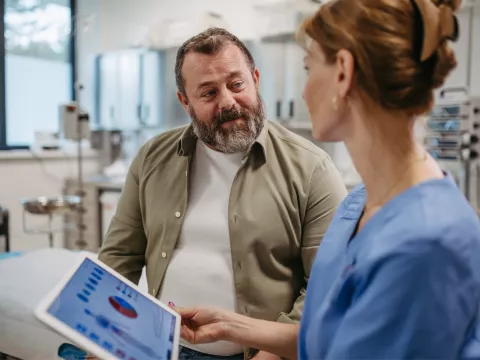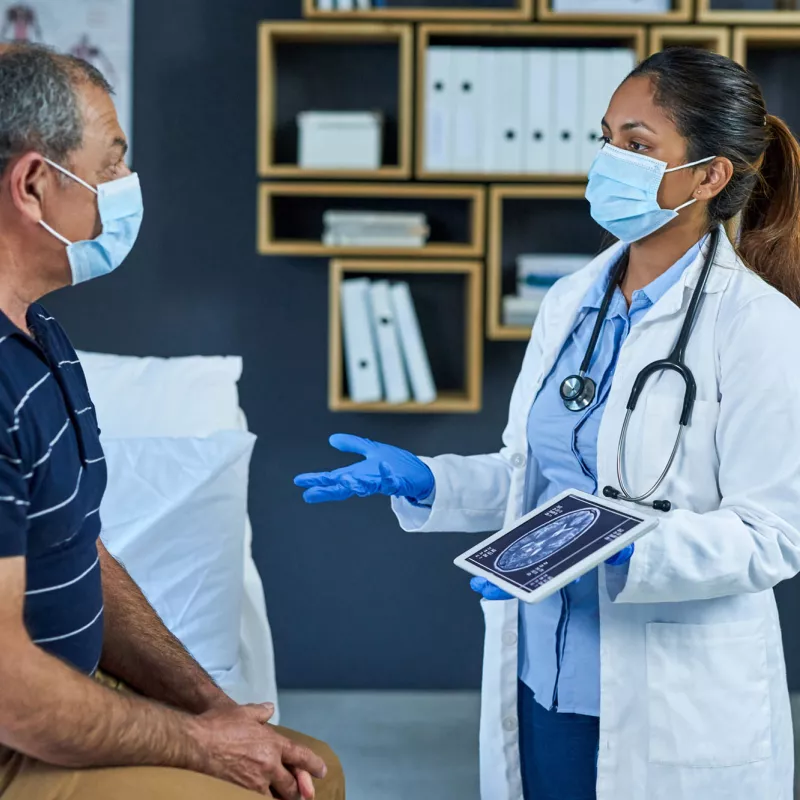
Brain Tumor Care That Eases Your Mind
A brain tumor diagnosis of craniopharyngioma is hard to face, but you don’t have to go it alone. At the AdventHealth Brain and Spine Institute, we’re here to ease your mind and guide your journey to better health with compassion and empathy.
With minimally invasive technologies and comprehensive care for all types of brain tumors, including craniopharyngiomas, we provide everything you need to move forward with confidence and feel like yourself again.
What to Know About Craniopharyngioma
- What Is Craniopharyngioma?
-
Craniopharyngioma is a rare type of benign (noncancerous) brain tumor that develops at the base of the brain and grows slowly. It’s usually found in children between 5 and 10 years old. However, craniopharyngioma can develop in adults as well.
As these tumors increase in size, they can press on the pituitary gland, a tiny gland that makes hormones that control other glands and many of the body’s functions.
- Common Craniopharyngioma Symptoms
-
Symptoms usually appear gradually and become more noticeable as the craniopharyngioma tumor gets bigger. Common ones may include:
- Excessive urination
- Fatigue
- Headache
- Nausea
- Problem with balance
- Vision changes
- Vomiting
- Craniopharyngiomas Diagnosis
-
Doctors use a physical exam as well as imaging and other tests to make a diagnosis, including:
A Physical Exam
A physical exam is usually the first step in diagnosing craniopharyngioma. During your appointment, your doctor may ask about your symptoms and medical history. The doctor may also do a neurological examination to evaluate your:
- Balance
- Coordination
- Growth and development (in children)
- Hearing
- Reflexes
- Vision
Blood Tests
Blood tests are sometimes used to check hormone levels. Issues with hormone levels could suggest a problem with the pituitary gland.
Imaging Tests
Craniopharyngioma imaging tests can include X-rays, magnetic resonance imaging (MRI) scans or computed tomography (CT) scans. These tests may confirm a diagnosis in someone with craniopharyngioma signs and symptoms or rule it out.
- Craniopharyngioma Treatments
-
Your doctor will work with you to determine the best options for treating you or your child. Factors such as health history and the size of the craniopharyngioma tumor guide treatment recommendations. Together, you’ll decide what’s best for your situation, with options like:
Brain Tumor Surgery
Whenever possible, we surgically remove all or most of a craniopharyngioma using both traditional surgeries and minimally invasive technology. Learn more about our minimally invasive brain surgery options.
Radiation Therapy
Several types of radiation therapy, including external beam radiation, proton beam therapy and intensity-modulated radiation therapy (IMRT), deliver very targeted radiation to treat craniopharyngioma.
Chemotherapy
Targeted chemotherapy allows us to inject powerful medications directly into a tumor. The medications effectively destroy tumor cells while protecting healthy surrounding tissues.
Learn more about our minimally invasive brain surgery options.

Our Comprehensive Brain Tumor Program
If you or a loved one have been diagnosed with craniopharyngioma, you have a lot on your plate. Let us lighten your load. We take care of all the details so you can concentrate on healing in body, mind and spirit.

Compassionate, Patient-Centered Care
We know that every person we see is unique, so we make sure your care is, too. We’ll evaluate your craniopharyngioma symptoms and your overall health to develop a treatment plan that’s best for you.

